If you’ve been dreaming of transforming your outdoor living space into a tropical getaway, then palm tree landscaping is the perfect way to bring your vision to life! The graceful lines and lush foliage of palm trees instantly upgrade any outdoor area, and with the right know-how and some careful planning, you can create an oasis in your own backyard. This guide will provide all the information and useful tips you need to plan and execute your ideal landscaping project.
Landscaping With Palm Trees: The Basics
Palm tree landscaping is becoming increasingly popular, and for good reason. only are they a great way to add natural beauty and tropical charm to your outdoor space, but they’re also low-maintenance plants that don’t require extensive care. When it comes to adding greenery to your garden or patio, palm trees can be an ideal choice.

Here are some of the basics you need to know before diving into a palm tree landscaping project:
- Understand Your Climate: Before investing in palms, ensure you understand what type of climate conditions will best suit them. Generally speaking, palms do well in hot climates with plenty of sun exposure. However, there are some varieties that can handle cooler, wetter climates as well.
- Choose the Right Palm Trees: Not all palm trees are created equal, so choose the right type for your specific needs and climate conditions. Some popular options include Sago Palms, Coconut Palms, Date Palms and Areca Palms. Take some time to research each one before making a decision.
- Plant Them in the Right Spots: You should consider where you want to plant the palms and how much sun exposure they will get throughout the day — otherwise, you risk stunting their growth or having them wither away and die in extreme temperatures.
- Prepare Your Soil: Before planting the palms, make sure you’re preparing the soil properly. Test the pH levels and add beneficial nutrients like sand or perlite to improve drainage.
- Water & Fertilize Regularly: Palms need regular watering — usually about once a week — and they should be fertilized every other month with specialized palm fertilizer to keep them healthy and strong.
Finally, remember that it takes time for any landscaping project to really take shape. With proper care and attention, however, your outdoor space will be transformed into an oasis of lush greenery in no time at all. Have fun experimenting with different varieties of palms to create a unique look that reflects your personal style.
Palms aren’t actually trees
One of the most misunderstood facts about palm trees is that they are not actually classified as trees. While they may look like trees, palms are actually more closely related to grasses than real trees. This means that when it comes to landscaping with them you won’t need to worry too much about pruning and other maintenance tasks typically associated with tree care.
Pinnate vs. palmate
When planning for a palm tree landscaping, it’s important to know the difference between pinnate and palmate. Pinnate leaves are arranged in feather-like shapes, while palmate leaves are folded in a fan-like pattern. The shape of the leaf can have an impact on how much sunlight the plant will get, as well as how it looks when planted.
Pinnate palms are best suited for areas that receive full sun or partial shade, while palmate palms work better in areas with less sunlight. For example, if you live in an area that gets a lot of direct sunlight throughout the day, pinnate palm trees may be the best option. On the other hand, if you’re in an area with more shade, palmate palm trees may work better.
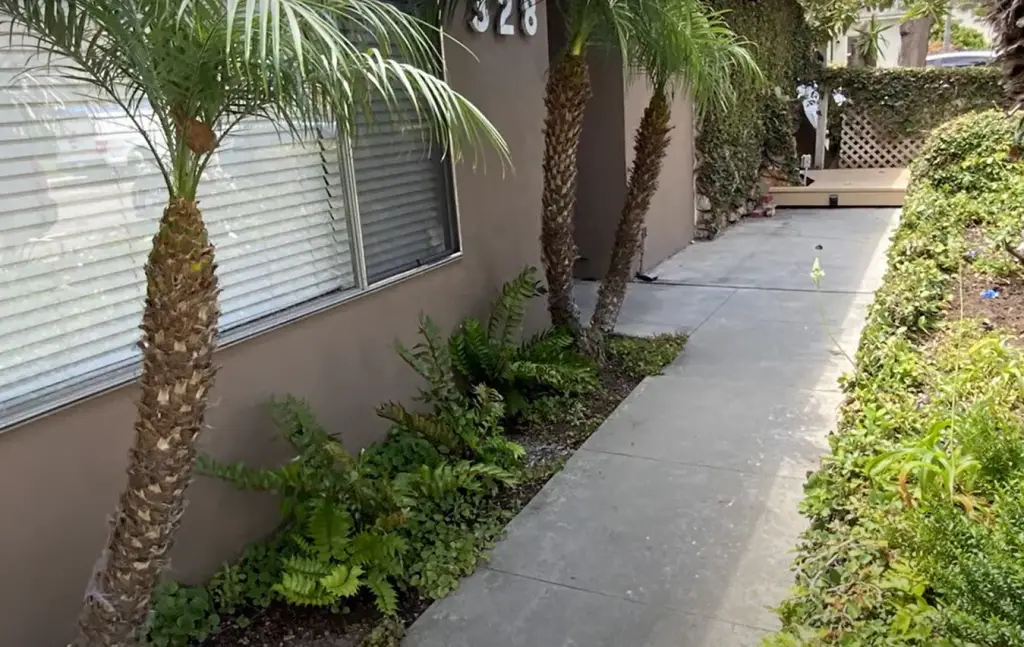
The shape of the leaf can also affect the aesthetic of your landscaping.
Choosing the right palm tree will depend on what overall effect you want to create. Consider how much sunlight is available and how it will impact the look of your landscape when deciding between these two types of palms.Palm tree maintenance
Once you’ve got your palms in the ground, keeping them healthy and happy is important. Most palms require pruning on a regular basis to maintain their shape, but be sure not to take off more than 25% of the tree’s foliage at once. When cutting back fronds, use sharp pruners or shears so that you don’t tear the leaves, causing damage to the tree. It would help if you also fertilized regularly using a balanced fertilizer specifically formulated for palms.
Finally, pay attention to your palm trees for any signs of disease or insect infestation. If you notice an issue, contact a local landscaping expert as soon as possible for assistance in treating the problem before it becomes worse.
Palms vs. cycads
When considering palm trees for your landscape, it’s essential to understand the difference between palms and cycads. Palms are a type of flowering tree that produce flowers or fruits, while cycads are an ancient type of coniferous tree with leaves like ferns. While both types of trees provide interest and texture to landscaping projects, they have different preferred growing conditions.
Palm trees need lots of sun and well-drained soil to thrive, whereas cycads prefer part shade and more moisture in the soil. If you’re looking for a dramatic statement in your landscape, then palms may be the best choice as they can grow up to 60 feet tall! But if you’re looking for something lower maintenance, then cycads may be the way to go, since they’re very hardy and require only minimal care.
Regardless of which type of tree you choose, it’s important to select a variety that is suitable for your climate. Some palm tree varieties are more cold-tolerant than others, so make sure you research the tree before purchasing it. Also consider the mature size of the tree when selecting a variety – some palms can grow quite large and may need pruning or regular trimming in order to keep them at a manageable size.
Ideas for Landscaping With Palm Trees
Palm trees are a perfect way to add a touch of tropical paradise to your outdoor space. Whether you want to create a lush oasis in your backyard or just want to bring in some extra texture and color, there are dozens of options when it comes to landscaping with palm trees. Here are some ideas for how you can use these distinctive plants:
- Create an exotic look by planting several types of palms together in clusters. The different colors and heights will create visual interest.
- Plant palm trees along pathways and driveways their majestic fronds will make any entrance more impressive.
- Use dwarf palms as accent pieces around pools or patios, as they won’t take up too much space.
- Plant a row of palm trees to create a natural privacy screen or windbreak in your yard.
- Add a dramatic effect by planting different varieties at varying heights throughout your outdoor space.
- To bring in some extra color, look for species with brightly colored foliage such as red, yellow, and purple.
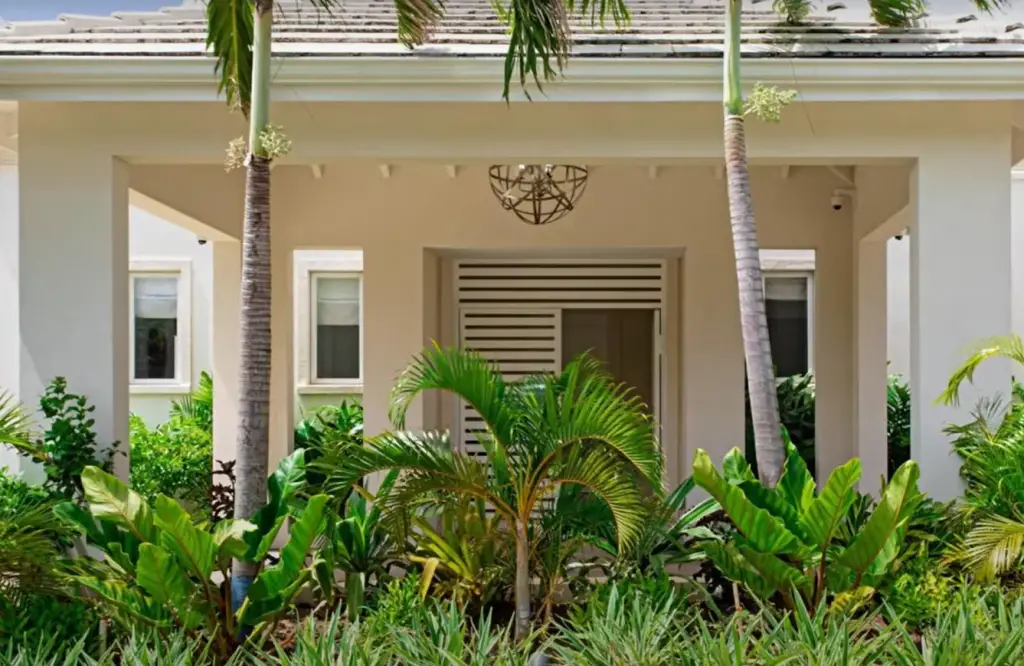
No matter what kind of landscape you have, there’s sure to be a type of palm tree that will fit perfectly into your design plan! With the right care and attention, you’ll have an eye-catching oasis in no time.
Try new colors
Adding colorful elements to your landscaping can create a unique and eye-catching look. Palm trees come in all, sizes, and colors, so you have plenty of options when it comes to creating a vibrant landscape. Consider adding brightly colored flowers or plants around the base of your palm tree for an extra pop of color. You could also use outdoor lighting to bring out the beauty of the tree at night. Whatever you choose, make sure it complements the overall look and feel of your design.
Landscape for privacy
If you’re looking to add privacy and a tropical feel to your garden, consider adding a row of palm trees. Not only will they provide the privacy you need, but they also look great framed against the sky. Depending on your space and budget, you can choose from single or multi-trunked palms ranging in size from small to very tall. Planting them at varying heights along one or two sides of your property is sure to give it an exotic, tropical feel.
They’ll be able to help you select the right species for your needs and provide tips on care and maintenance. For additional privacy, you can also add a low hedge of flowering shrubs in front of your palms for added color and texture. Together with the palm trees, it’ll create a beautiful, tropical oasis that will be the envy of all your neighbors!Accentuate with a row of palm trees
If you are looking for a stylish way to make your garden aesthetically pleasing, then lining the boundaries with a row of palm trees is the perfect idea. A single row of palms can give symmetry and balance to your landscape and add character. Depending on the variety of tree chosen, they can provide both height and texture to your yard. Whether you’re partial to date palms or swaying coconut trees, they will definitely make an impact.
When selecting palm trees for landscaping, it is important to consider their growth rate, size at maturity as well as overall appearance in order to choose the right one for your space. One thing that should also be taken into account is climate; different types of palms are better suited to different, so be sure to do your research before adding them to your garden.
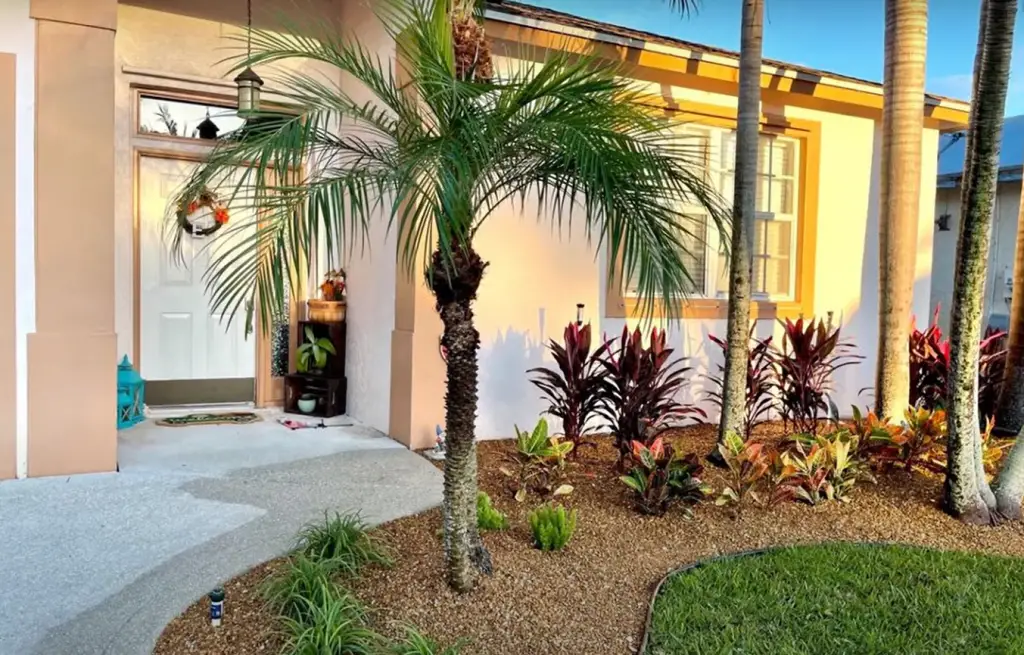
A great way to ensure that they look their best is by planting them in a single line, as it allows for uniform maturity and height of the trees. This can help create an eye-catching landscape without taking up too much space in the yard. Additionally, regular trimming and pruning will help maintain the shape of the tree and keep them looking neat.
Shade the pool
If you have a swimming pool, then adding palm trees to your landscaping can be the perfect way to provide natural shade. Planting your palms in a semi-circle the edge of the pool will keep it cool and provide shelter from direct sunlight. This is an especially good idea if you live in a sunny climate as it will help protect swimmers from sunburns and heat exhaustion. Plus, with their large, lush fronds, palm trees offer a great tropical look that’s sure to give your outdoor space an exotic feel. You’ll also enjoy watching birds, bees and butterflies flit between the branches!
Shade The Home
Palm trees make great shade for your home or outdoor space. Planting a few palms in strategic locations can provide plenty of cover and create a tropical feel to any area. They’re also fairly low maintenance, so you won’t have to worry about trimming or regularly pruning the trees. However, be sure to give them enough space from the house so their roots don’t damage any structures.
Shade Outdoor Seating
If you want to add shade and style to your outdoor seating areas, why not look into palm tree landscaping ideas? The tall trunks of the palms make them ideal for providing shade while also creating an interesting aesthetic. Plant a few palms along one side of your seating area to provide dappled shade that allows you to relax outdoors without feeling too exposed. To complement the tropical vibe, use other plants in bright colors and shapes like Heliconia and Bougainvillea. A tiki bar or bamboo furniture can help complete the scene!
Highlight the flower beds
Palm trees are a great tree to use if you want to add a bit of drama or color to your flower beds. They can provide some nice contrast in height, texture and shape that traditional plants might not be able to provide. When choosing palm trees for your flower beds, make sure you select ones that have low water requirements and are suitable for the climate in your area. If you’re looking for something more tropical-looking, opt for varieties like the Canary Island Date Palm or Phoenix Roebellini Palm. These will look amazing when planted alongside bright flowers and other foliage plants. Make sure they’re spaced well apart so they don’t crowd out other plants in the bed. Finally, remember to prune your palm trees as necessary to keep them at a more manageable size.
Partner with Boxwoods
A great way to soften the sharp lines of your palm trees is by planting boxwoods alongside them. Not only will this create a nice contrast in textures, but it will also help frame the fronds of your palms in an interesting way.
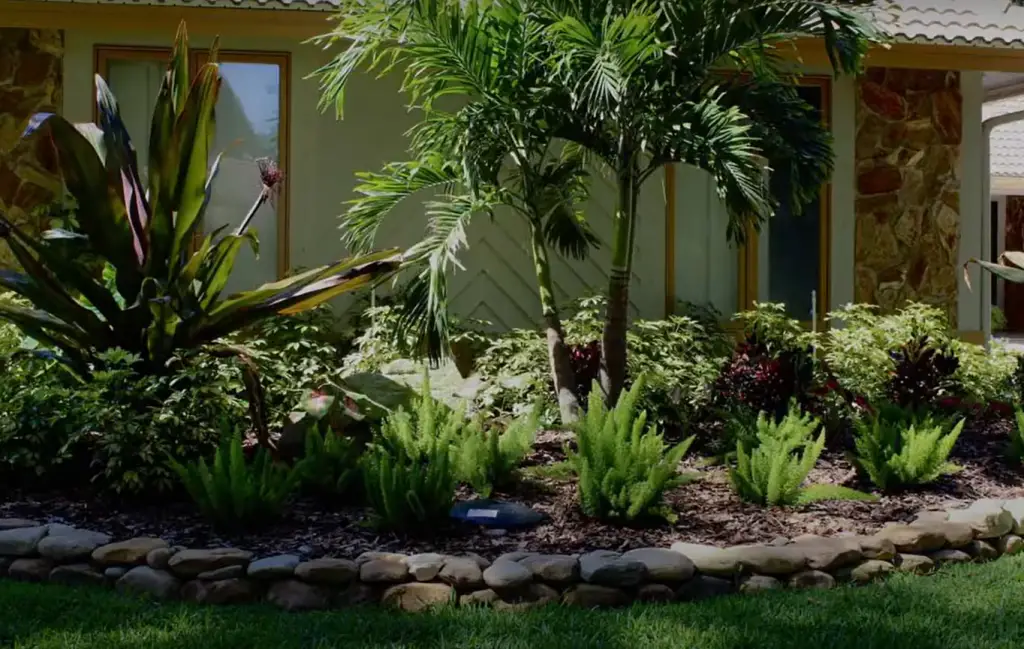
Plus, boxwoods are quite low-maintenance so you won’t have to worry about taking care of them too much. Just make sure that they don’t overpower or cover the palms – keep some distance between the two plants for best results.
Create a garden centerpiece
Palm trees are perfect for creating a garden centerpiece. Whether you have a small city garden or an expansive estate, adding some palm trees to the mix can create visual interest and provide much needed shade for your outdoor space. Here are some ideas on how to use palm trees as part of your landscaping design:
- Plant two tall palms in an area with plenty of sun and group a few smaller palms around them. This creates an eye-catching focal point that draws attention and gives the space height and character.
- Place one or more palms near water features such as ponds and fountains. The combination of plants, water, and sunlight will create beautiful reflections off the surface of your pond or fountain, making your garden look even more enticing.
- Surround a patio area with palm trees for maximum shade and privacy. This is the perfect way to create an outdoor living space that feels like an oasis away from the hustle and bustle of everyday life.
- Plant a single tall palm in the middle of your lawn or garden as an elegant centerpiece. Not only will it add height, but its delicate fronds will move gracefully in the breeze, creating a tranquil atmosphere.
Now that you know how to use palm trees for landscaping purposes, make sure to choose the ones that are best suited for your climate and soil type.
Glow up with landscape lighting
Lighting up your palm tree is a great way to really make it pop in the landscape. It’s also important if you’re wanting to enjoy these plants at night! Various low-voltage lighting like spotlights and floodlights can be used to illuminate paths, walls, and of course trees. Colored lights will instantly transform your landscape into an outdoor oasis that looks stunning. Lights aren’t just for aesthetics either — they can provide safety after dark and even deter unwanted critters from entering your yard. If you don’t have an existing electrical system, you may want to consider solar lighting so there are no wires or cords needed. With proper installation, some quality landscape lighting could turn your ordinary yard into something extraordinary.
Add some cactus
Cacti are the perfect accompaniment to a palm tree landscaping theme. They add texture and height, creating a unique contrast with the tall, single-trunk palms. Arrange some prickly Mexican hedgehogs or cylindrical columnar cacti throughout your landscape for an added touch of desert beauty.
You could also incorporate some drought-tolerant succulents like Burro’s Tail or Sedum into your design for extra layers of color and texture. Whatever you choose, adding cacti to your outdoor space will give it a unique and exotic feel.Complete a rock garden
Using rocks around your palm trees is a great way to create texture and interest in the landscape. Rocks also draw attention away from any imperfections that may exist in the area, like exposed roots or barren patches of soil. To make a rock garden, simply arrange large stones around the tree’s base in an attractive pattern. You can even mix different types of rocks for an interesting effect!
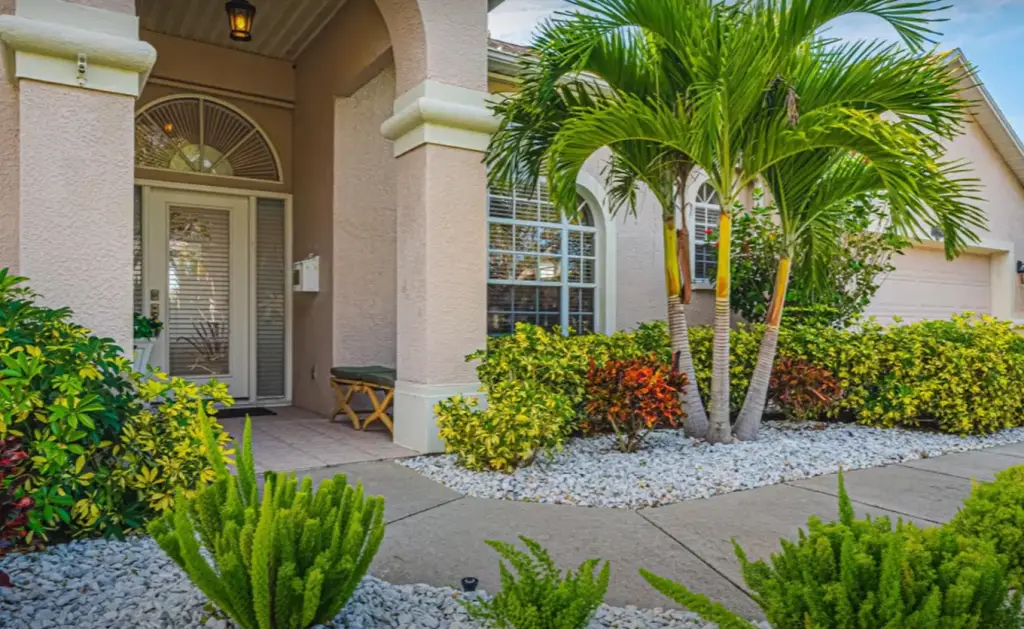
Adding other plants or small shrubs near the stones will give it an extra pop of color and life. Finally, complete your design by laying down mulch or gravel around the stones so they don’t move out of place over time due to wind or rain.
Cool off on the balcony
When you’re looking for some palm tree landscaping ideas to transform your outdoor space, why not cool off on the balcony with a few hardy palms? This is a great idea if you want something to provide shade or privacy without taking up too much room. Choose a smaller variety of palm such as Pygmy date palm, Areca palm, or Foxtail palm. They are all easy to care for and will easily fit into tight spaces like balconies and porches. Make sure that they get enough sunlight and keep them well-watered so they thrive in their new home! You could also try training some varieties of climbing plants such as Bougainvillea or Passionflower around the base of your palms for a lush tropical look.
Another great idea, if you have a balcony or porch, is to hang some potted palms in baskets, which will add an exotic touch to your outdoor space. A few of the most popular varieties for hanging baskets include Fishtail palm, Triangle palm, Bamboo palm and Parlor palm. They are all easy to care for and make sure that they get enough light and water!
Frame the home or entryway
One of the best ways to make a statement with your landscaping is to frame your front entry or home with the beauty of palm trees. Whether you want a modern and bold look, or something more tropical and inviting, palm trees are the perfect way to create an impactful entrance. Planting a row of palms around your front yard can give it that extra bit of elegance, making sure your guests know they’ve arrived in style! Plus, as long as you keep an eye on trimming and pruning needs, these trees won’t require too much care or maintenance.
Plan ahead for blooms
If you’re looking to add some color to your yard, then planning ahead is key. Many palms bloom during certain seasons and may not re-bloom until the following season. Consider what type of palm tree would look best in your landscape and when it typically blooms so that you can be sure to have color in your garden all year round. Additionally, consider Palm trees with berries or colorful foliage to bring a different kind of beauty to your yard.
Extend your container garden
Container gardening with palm trees is a great way to add interest and texture to your outdoor space. A single potted specimen on the patio or near the pool will create an instant tropical oasis, while larger groupings can completely transform your yard into a lush paradise! When selecting containers for planting, aim for ones that are large enough to accommodate your palms’ mature size and have adequate drainage. Consider placing several pots in different sizes and colors around the garden to create visual depth and texture.

Be sure to also add other plants around the base of each pot, as this will help boost soil nutrients and bring more life into your landscape design. Think about pairing colorful blooms with drought-tolerant succulents or foliage plants with striking foliage. This will ensure your palms are always the star of the show!
In addition to creating a captivating container garden, you can also plant palm trees directly into the ground. Just be sure to give them plenty of room so their root systems have enough space to spread and grow over time. Furthermore, you may need to amend your soil with organic material or mulch if you want to encourage optimum growth. A few inches of compost or bark chips around each tree’s base will provide extra nutrients while also helping retain moisture in dryer climates.
Shoot for the moon
When it comes to designing your dream landscape, don’t be afraid to think big and go for bold ideas. Palm trees can add drama and a sense of sophistication to any space. Whether you’re aiming for a tropical paradise or a classic backyard oasis, the right combination of palm trees can take your vision one step closer to reality.
Start by considering the size and shape of the area you have available, then decide which types of palms best suit your design. You may want to mix things up with different varieties that provide texture and contrast or pick just one species that provides a uniform look throughout. Don’t forget about color — some species offer vibrant hues year-round, while others change seasonally or slowly over time.
Don’t forget to factor in the climate of your region when selecting palm trees. Talk to a knowledgeable professional or research online to ensure you choose species that will thrive in your area and be able to tolerate whatever mother nature throws at them. Proper planting and maintenance can help keep your palms looking great for years to come!
When to Call a Landscaping Pro
Although you may be confident in your landscaping skills and feel capable of taking on the task of planting palm trees yourself, it’s always good to have professional check things over. Here are some times when calling a pro is recommended:
- If you’re unsure about which palm species to use, an experienced landscaper can provide advice on which type will work best with your climate and soil conditions.
- If you need help determining where best to plant them and how to keep them healthy, they’ll be able to advise you on the most suitable location.
- If you want tips for maintaining the overall appearance of your garden or would like assistance choosing other plants or accessories that will complement the palms, professionals can offer valuable advice.
- If you plan to use large palms, it’s best to get the help of a pro for planting and ensuring that they are properly secured and staked. This is especially important for tall varieties like Queen or Canary Island Date Palms. [1]
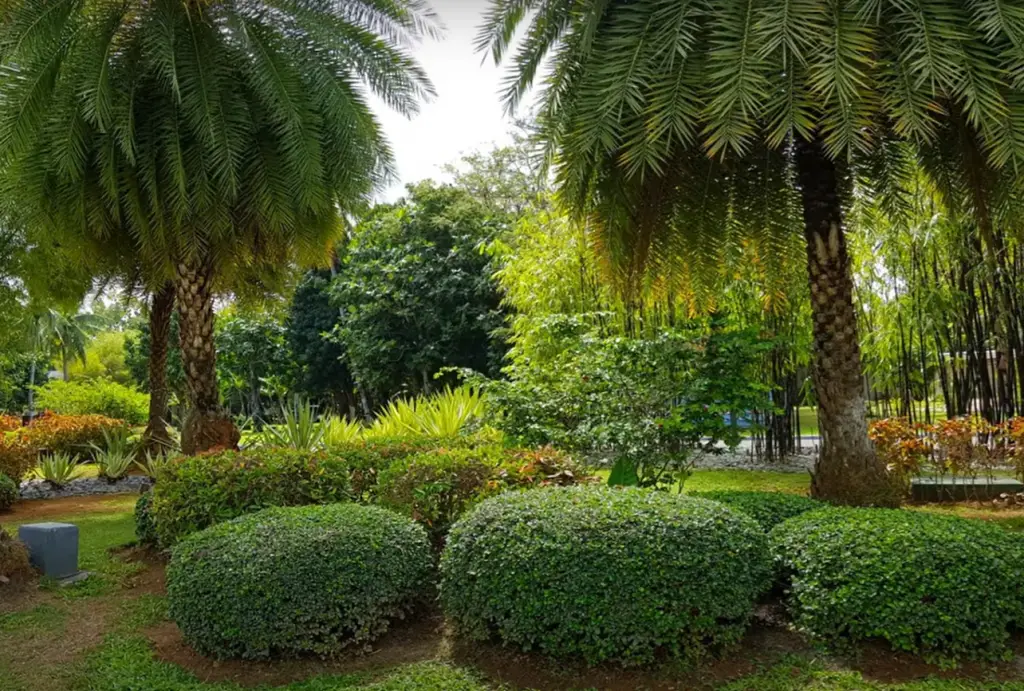
Working with a professional landscaping service will help ensure the success of your palm tree landscaping project, so be sure to call one in at the right time! With their expertise and knowledge, they’ll be able to provide invaluable assistance in creating an attractive outdoor space that not only looks great but also meets all of your needs.
FAQ
What is best to put around palm trees?
Palm trees look best when surrounded by other tropical plants, such as elephant ear, crotons, and bromeliads. Rocks and stones can also be used to create a more natural, serene atmosphere. If you’re looking for something a bit more dramatic, consider using bold colors or textures like large containers filled with flowers or colorful pots. Whatever you choose, make sure it complements the overall look of your palm tree landscaping design. [2]
What do palms do in the landscape?
Palms are a great addition to a landscape for many reasons. They can provide shade and privacy, bring texture to the landscape with their unique fronds, and even act as a focal point in your yard. Palms also help to protect against wind, reduce noise levels, attract birds and other wildlife, and can act as a natural air conditioner in hot climates. With so many benefits it’s no wonder that palms are one of the most popular landscaping options around!
When choosing palm trees for your landscape there are several factors to consider. It is important to take into account the size of the tree you want as some varieties can be quite large while others remain fairly small. Additionally, you should think about how much sunlight the tree will need, what type of soil your yard has, and if you want to use the palm for privacy or for decoration. There are many different varieties of palms so there is sure to be one that will fit your needs perfectly!
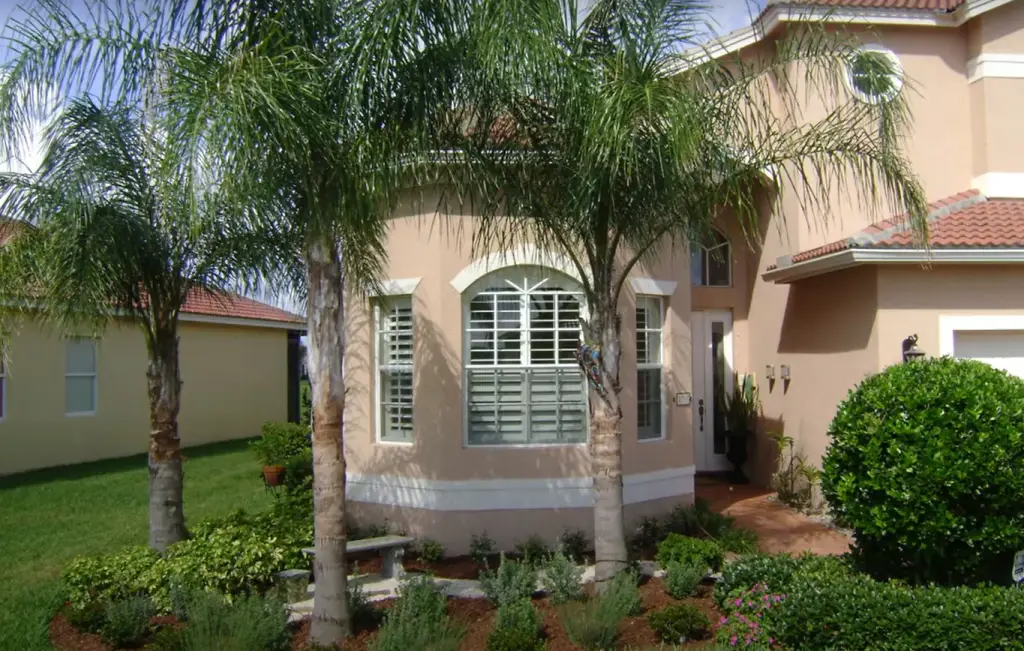
Once you have chosen the perfect palm tree for your landscape, it’s time to start planning out how to use them in your landscaping design. Palms can be used as a focal point in a garden bed, lining an outdoor walkway, or even as part of a hedge-like border. Consider adding other greenery such as shrubs, flowers and grasses around the palms to further enhance their beauty. Additionally, lights can be added near or around the trees to create a beautiful atmosphere in the evening. [3]
Palm trees are a great addition to any landscape and with the right planning, they can truly help create an oasis in your own backyard. So get creative and start brainstorming how you want to use palms in your landscape!
How do you plant around a palm tree?
When you’re landscaping around a palm tree, it’s important to take into consideration the size of your tree and its spread. You also want to be aware of the trees growth rate and how much space there is for other plantings in the area. Palm trees typically need little pruning or trimming, so a bit of extra care should be taken when planting next to them.
To get started, choose plants that are compatible with palm trees—such as drought-tolerant succulents, grasses, groundcovers and shrubs — which can help complement the look of your palm tree’s foliage. Make sure they don’t cast too much shade on other plants in the area, and ensure they get plenty of sunlight.
If you’re looking to create a more vibrant landscape with additional color or texture, consider edging your palm tree with annuals such as petunias, impatiens or marigolds. Bulbs like daffodils and tulips can also be planted in the fall for a beautiful spring display.
When planting near a palm tree, it’s important to keep the soil well drained. You may need to amend the soil with compost or other organic matter if it doesn’t drain properly. Finally, don’t forget to water regularly during dry spells as palms typically require more frequent watering than most plants.
Where is the best place to plant a palm tree in the garden?
it comes to landscaping with palm trees, the best place to plant them is in an area that receives a lot of sun. This will ensure that your palms get enough light and heat to grow healthy and strong. You should also look for an area that has good drainage, as waterlogged soil can cause problems for your palms. Make sure to choose a spot where the surrounding plants won’t block sunlight from reaching your palm tree, as this could stunt its growth. Consider choosing a spot near other tall plants or structures such as fences and buildings, which will help protect it against strong winds. Finally, make sure you pick a location far away from any power lines or other electrical sources, as these could be hazardous to your palm tree. [4]
Useful Video: 35 Palm Tree Garden Ideas
Conclusion
When it comes to landscaping with palm trees, you have many options to choose from. Whether you’re looking for a tropical oasis in your backyard or an elegant feature of your front yard, palms are the perfect choice to bring your vision to life. With so many sizes, shapes, and colors available, it’s easy to find the perfect type of palm tree suited for your space and style. Before selecting a palm tree for planting in your yard, be sure that you have enough room and light for it to thrive. Additionally, be sure to research climate-appropriate varieties of palms and maintenance requirements. Taking these steps ensures that you will get years of enjoyment out of your investment by creating a beautiful landscape full of lush and vibrant palm trees.
If you’re looking for a way to spruce up your outdoor space, consider the beauty of incorporating palms into your landscape design. With the right preparation, attention, and care, you can create an eye-catching oasis that perfectly complements your home. From towering Washingtonia Robusta palms to striking Bismarck Palm trees, there are endless possibilities when it comes to landscaping with palms – making it easy to make your yard stand out!
References:
- https://www.lawnstarter.com/blog/landscaping/how-to-landscape-with-palm-trees/
- https://www.evergreenseeds.com/what-to-put-around-palm-trees/
- https://lawnlove.com/blog/choosing-palms-for-your-landscape/
- https://www.wikihow.com/Plant-a-Palm-Tree










Leave a Reply
View Comments